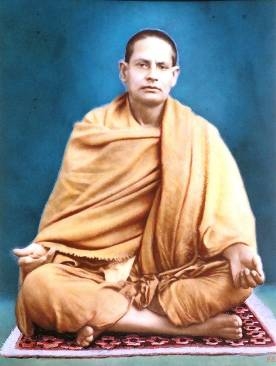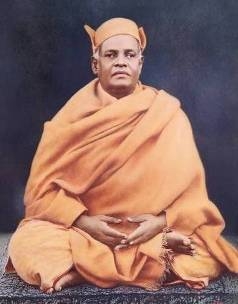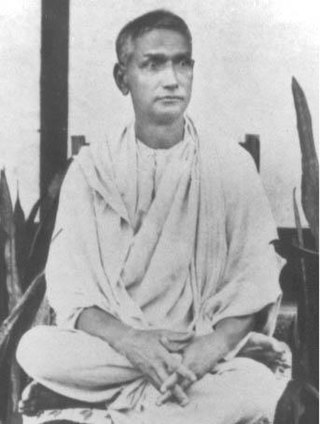
Sri Sarada Devi, born Kshemankari / Thakurmani / Saradamani Mukhopadhyay, was the wife and spiritual consort of Ramakrishna Paramahamsa, a nineteenth-century Hindu mystic. Sarada Devi is also reverentially addressed as the Holy Mother by the followers of the Sri Ramakrishna monastic order. The Sri Sarada Math and Ramakrishna Sarada Mission situated at Dakshineshwar is based on the ideals and life of Sarada Devi. She played an important role in the growth of the Ramakrishna Movement.

Swami Vijnanananda was an Indian monk of Ramakrishna order, born in an upper-class family near Dakshineswar, and was a direct disciple of Ramakrishna. He was an engineer and worked as the District Engineer in the erstwhile State of United Provinces, India. He was a great scholar of Sanskrit with expertise in religio-philosophical works, astronomy, civil engineering etc. He spent considerable time in Allahabad (Prayag) centre of Ramakrishna Math. He became the President of Ramakrishna Mission in 1937. It was under his presidency and direct supervision that the Ramakrishna Temple at Belur Math was constructed and consecrated.

Shuddhananda who was the fifth president of the Ramakrishna Order, was a direct monastic disciple of Vivekananda. He joined the Ramakrishna Math in 1897. He became a trustee of Ramakrishna Math and a member of the governing body of Ramakrishna Mission in May 1903. He also took up the editorship of the Bengali magazine called Udbodhan for sometime. He was appointed as the secretary of the math and the mission in 1927 and as the vice president in 1937. In 1938, he became the president of the order. His tenure was short, as he died in 1938. He is renowned in the literary circles to have translated most of Vivekananda's original works from English to Bengali.

Swami Virajananda, born Kalikrishna Bose, was an initiated disciple of Sarada Devi and the sixth president of the Ramakrishna Order. Born as the son of Trailokyanath Bose and Nishadkalidevi, Virajananda was the first person to join the Ramakrishna Order after the direct disciples of Ramakrishna. In 1897, he was initiated into sannyasa by Vivekananda. From 1899 onward he served in Advaita Ashrama, Mayavati and became its president in 1906. He is recognised as a monastic disciple of Vivekananda.

Belur Math is the headquarters of the Ramakrishna Math and Ramakrishna Mission, founded by Swami Vivekananda, the chief disciple of Ramakrishna Paramahamsa. It is located in Belur, West Bengal, India on the west bank of Hooghly River. Belur Math was established in January 1897, by Swami Vivekananda who was the disciple of Sri Ramakrishna. Swami Vivekananda returned back to India from Colombo with a small group of disciples and started work on the two one at Belur, and the others at Mayavati, Almora, Himalayas called the Advaita Ashrama. The temple is the heart of the Ramakrishna movement. It is notable for its architecture that fuses Hindu, Islamic, Buddhist, and Christian art and motifs as a symbol of unity of all religions. In 2003, Belur Math railway station was also inaugurated which is dedicated to Belur Math Temple.

Ramakrishna Paramhansa Deva had sixteen direct disciples who became monks of the Ramakrishna Order; they are often considered his apostles. In the Ramakrishna-Vivekananda movement, the apostles have played an important role. Apart from Swami Vivekananda, the direct disciples or apostles of Ramakrishna were as follows.

Balaram Bose was one of the prominent householder disciples of Ramakrishna Paramahamsa. He was the son of Radhamohan Bose. He is often referred in The Gospel of Sri Ramakrishna. Ramakrishna often visited his house and participated in kirtana and other devotional functions. Sri Maa Sarada Devi and some other devotees of the master, including Swami Adbhutananda lived in the house of Balaram Bose after the master's death. He was a great philanthropist and donated regularly to government and civilian organizations.

Ramakrishnananda was one of the direct disciples of Ramakrishna. Known for his "Gurubhakti" [Service to the Guru], he served the Baranagore Math for 12 years without missing a single day.

Akshay Kumar Sen was one of the lay disciples of Sri Ramakrishna, the 19th century Bengali mystic and saint. He was the author of the book Sri Ramkrishna Punthi, a long narrative poem on the life and teachings of one of the most illustrious figures of 19th-century India. After reading the work, Swami Vivekananda wrote from the United States to a brother monk in India, "Give Akshaya a hundred thousand hearty embraces from me. Through his pen Sri Ramakrishna is manifesting himself. Blessed is Akshaya."

Baburam Maharaj (Swami Premananda) (Bengali: বাবুরাম মহারাজ; 10 December 1861 – 30 July 1918) was a direct disciple of Ramakrishna, the 19th-century saint and mystic from Bengal, India. He was born in Antpur in the Hoogly district of Bengal in the year 1861. Baburam, as he was called in his pre monastic days, was also related to Balaram Bose, a leading householder disciple of Ramakrishna. He was given the name of Premananda or "joy of divine love" by his brother disciple Vivekananda. He had a notable contribution during the initial days of Ramakrishna Mission as he managed the whole affairs of Belur Math from 1902 to 1916. He also mentored young spiritual aspirants.

Swami Yogananda was a disciple of Ramakrishna Paramahansa, the 19th-century mystic. He took his formal initiation from Sarada Devi, the "holy mother" of Ramakrishna paramhansa Order and spiritual consort of Ramakrishna. He was the first vice-president of Ramakrishna Mission. He belonged to the family of Sabarna Roy Choudhury, an aristocratic family of erstwhile Bengal. He had a very short life, but he played a very important role during the formative years of Ramakrishna Mission. He was also a dedicated and devoted attendant to Sarada Devi during her stay in Calcutta after Ramakrishna paramhangsha's death. He was one of the disciples whom Ramakrishna paramhangsha referred to as "Iswarakoti" or the "ever perfect soul".

Swami Niranjanananda (Senior), born as Nitya Niranjan Ghosh, usually called by the shortened name of Niranjan, was one of the foremost monks of Ramakrishna Mission and was one of the direct monastic disciples of Ramakrishna. Niranjanananda was one of those few disciples, whom Ramakrishna termed as "Nityasiddhas" or "Ishwarakotis" – that is, souls who are ever perfect. [Niranjanananda is termed Senior since there was another swami, Niranjanananda (Junior) also known as Pandalai Maharaj, later in the Ramakrishna Mission who died in 1972]. Even though his tenure with the newly formed Ramakrishna Mission was short-lived owing to his early death, he left an indelible mark in spiritual and philanthropic activities. He had a majestic appearance, being tall with broad shoulders and strong physique.

Saradananda, also known as Swami Saradananda, was born as Sarat Chandra Chakravarty in 1865, and was one of the direct monastic disciples of Ramakrishna. He was the first Secretary of the Ramakrishna Math and Ramakrishna Mission, a post which he held until his death in 1927. He established the Udbodhan house in the Bagbazar area of Calcutta, which was built primarily for the stay of Sri Sarada Devi in Calcutta, from where he used to publish the Bengali magazine Udbodhan. There he wrote Sri Sri Ramakrishna Lilaprasanga in Bengali, on the life of Ramakrishna, which was translated into English as Sri Ramakrishna, the Great Master. He is believed to be reincarnation of Saint Peter and he allegedly went into Samadhi when he was in the Saint Peter Church and said that "I remembered my past" and wrote in his diary that "Saint Peter again."

Trigunatitananda, premonastic name Sarada Prasanna Mitra, was a direct disciple of Ramakrishna, the 19th-century Indian Hindu mystic and sant. He established the monthly Bengali magazine Udbodhan of Ramakrishna Math and later, at the behest of Vivekananda, went to America in 1902 and took charge of the San Francisco centre.

Subodhananda, born as Subodh Chandra Ghosh, was a direct monastic disciple of Ramakrishna, the 19th-century saint and mystic from India. The youngest of the direct monastic disciples, he was affectionately known by his brother monks, whose leader was Swami Vivekananda, as "Khoka". He played a pioneering role in establishing the Ramakrishna Math and the Ramakrishna Mission. He was one of the first group of trustees of the Belur Math appointed by Vivekananda in 1901, and was afterwards elected treasurer of the Ramakrishna Mission.

Nirmalananda, born as Tulasi Charan Dutta in Calcutta, was a direct disciple of Ramakrishna, the 19th-century mystic and Hindu saint from India, and took Sanyasa from Vivekananda along with Brahmananda and others. He was initiated by Sri Ramakrishna, on which fact a few latter-day antagonists tried to cast doubt in the Bangalore Court, but into which question the Court refused to get into. Nirmalananda played a key role in establishing Ramakrishna Math and Mission chiefly in South India, in Kerala and Bangalore and Tamil Nadu and also in the USA, Burma and Bangladesh.

Baranagar Math or Ramakrishna Math, Baranagar was the first monastery of Ramakrishna Order. In September 1886, after the death of Ramakrishna, when his devotees stopped funding, Swami Vivekananda and other disciples of Ramakrishna decided to make a dilapidated house at Baranagar their new math. The house crumbled to dust in 1897. In 1973 Vivekananda Math Samrakshan Samity was formed who attempted to preserve the area. In 2001, the possession was handed over to Belur Math authority, who soon-after declared it as one of their official branch. The restoration and development work of the area is still going on.

Sarat Chandra Chakravarty was a direct householder disciple of Swami Vivekananda and was the chronicler of "Diary of a Disciple" which is one of the major sources of first-hand information on Vivekananda's biography and teachings in the later stage of his life. Sarat Chandra was intimately connected with the Ramakrishna Order throughout his life, and even before the return of Swami Vivekananda from the West in 1897 he had been associated with the old monastery in Alambazar and with the direct disciples of Sri Ramakrishna. He was also a Sanskrit scholar and was a Post master by profession in the British Government service.
Alambazar Math is the second monastery of the Ramakrishna Order established in February 1892, which remained the order's headquarters till February 1898, when it was finally moved to Belur village on the bank of Ganga.

Gopaler Ma was a devotee and a householder disciple of Sri Ramakrishna, the saint and mystic from Bengal. Her birth name was Aghoremani Devi, but she came to be known as Gopaler Ma among the devotees of Sri Ramakrishna, owing to her intense motherly love for Sri Ramakrishna as "Gopala" or baby Krishna. She was famous for her divine visions of Lord Krishna as a baby and her devotion to the ideals of Sri Ramakrishna. In her later years, she was very close to Swami Vivekananda and Sister Nivedita. She spent the last few years of her life with Sister Nivedita.




















